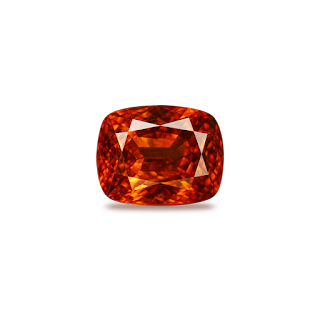In the kaleidoscopic world of gemstones, Hessonite stands out with its warm, earthy tones and rich celestial legacy. Often dubbed the “cinnamon stone” for its signature orange-brown hues, this gem is more than just a visual delight-it’s a bridge between ancient lore, astrological wisdom, and modern jewelry trends. Whether you’re a gem collector, astrology enthusiast, or someone seeking a unique accessory, Hessonite’s mystique is undeniable. Let’s delve into its origins, properties, and why it’s cherished across cultures.
What is Hessonite?
Hessonite, a variety of grossular, derives its name from the Greek word hesson, meaning “inferior,” a nod to its historically lower hardness compared to other garnets. Scientifically classified as a calcium aluminum silicate, its colors range from honey-yellow to deep reddish-brown, often resembling the spice it’s named after.
Key Characteristics:
- Chemical Formula: Ca₃Al₂(SiO₄)₃
- Hardness: 6.5-7.5 on the Mohs scale.
- Sources: Primarily Sri Lanka, India, Brazil, and Tanzania.
- Unique Feature: Treacly inclusions caused by manganese deposits, giving it a “whisky in water” effect.
Unlike its gem-grade garnet cousins like pyrope or almandine, Hessonite’s softer glow and organic tones make it a favorite for bohemian and vintage-inspired designs.
History and Lore: From Ancient Civilizations to Astrology
Hessonite’s legacy spans millennia. The Romans carved it into signet rings, while Egyptian pharaohs entombed it as a symbol of protection. In Vedic astrology, it’s revered as Gomed or Gomedh, one of the nine sacred navaratnas linked to Rahu, the shadow planet. Wearing Hessonite is believed to neutralize Rahu’s malefic effects, fostering clarity and success.
Medieval Europeans carried it as a talisman against poison and negativity. Even today, Sri Lankan miners whisper tales of Hessonite’s power to ward off nightmares when placed under pillows.
Physical and Metaphysical Properties
Physical Traits:
- Color: Ranges from pumpkin orange to mahogany, often with a vitreous luster.
- Clarity: Typically included; translucent to opaque.
- Refractive Index: 1.730-1.760, giving it moderate brilliance.
Metaphysical Benefits:
- Root Chakra Activation: Grounds energy, enhancing stability and courage.
- Healing: Believed to aid digestion, detoxify blood, and boost vitality.
- Emotional Balance: Dispels fear, fosters creativity, and encourages self-trust.
- Spiritual Growth: Facilitates karmic healing and past-life exploration.
Ayurvedic texts praise Hessonite for balancing the kapha dosha, while crystal healers use it to align the body’s energy fields.
How to Identify Authentic Hessonite
With imitations like dyed quartz or glass flooding markets, authenticity checks are crucial:
- Inclusions: Look for swirling “treacly” patterns under a loupe.
- Refractive Index Test: A gemologist can measure its RI (1.73-1.76).
- Specific Gravity: Ranges from 3.57-3.73, denser than most fakes.
- Certification: Always request a lab report from GIA or AIGS.
Pro Tip: Genuine Hessonite feels cooler to the touch than plastic or glass.
Hessonite in Jewelry: Timeless and Trendy
Hessonite’s durability makes it suitable for everyday wear, though it’s best in protective settings like bezels. Popular designs include:
- Rings: Statement cabochons in rose gold.
- Pendants: Raw, uncut stones for bohemian flair.
- Beaded Bracelets: Paired with amber or lapis lazuli.
In India, Hessonite is often set in panchdhatu (five-metal alloy) for astrological jewelry, while Western designers favor minimalist silver bezels.
Healing Properties: Fact or Folklore?
While scientific evidence is scant, anecdotal accounts abound:
- Physical: Users report improved circulation and allergy relief.
- Emotional: Aids in overcoming addiction and fostering resilience.
- Spiritual: Meditators use it to enhance intuition and lucid dreaming.
- Caution: Hessonite complements but shouldn’t replace medical treatment.
Caring for Your Hessonite
- Cleaning: Use mild soap, water, and a soft brush. Avoid steamers.
- Storage: Keep separate from harder gems like diamonds.
- Energetic Cleansing: Recharge under moonlight or with sage smoke.
Buying Guide: Tips for Smart Shoppers
- Color Priority: Vibrant cinnamon tones command higher value.
- Clarity: Accept minor inclusions-flawless stones are rare.
- Cut: Well-proportioned facets maximize brilliance.
- Budget: Prices range from 50-200 per carat, depending on origin and size.
- Top Sources: Reputable dealers like Gemfields or local astrologer-approved vendors.
Conclusion: The Stone of Earth and Sky
Hessonite Garnet captivates with its duality-a gem rooted in earthly beauty yet soaring with cosmic significance. Whether you’re drawn to its healing aura, astrological promise, or rustic charm, this cinnamon stone is a testament to nature’s artistry. As you explore its wonders, remember: authenticity is key. Invest in certified Hessonite, and let its warm glow illuminate your journey.














0 Comments